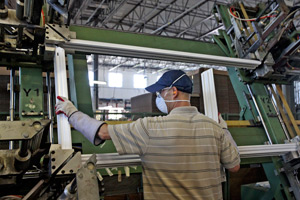Companies in US Added 241,000 Workers in December, ADP Says

Companies added more workers than forecast in December, indicating the U.S. job market was sustaining strength as 2014 drew to a close, according to a private report based on payrolls.
The 241,000 increase in employment was the biggest since June and followed a 227,000 November gain that was more than initially reported, figures from the Roseland, New Jersey-based ADP Research Institute showed today. The median projection of 45 economists surveyed by Bloomberg called for an advance of 225,000 last month.
Headcounts are growing as the world’s largest economy strengthens, powered in part by a pickup in household purchases. Labor Department data in two days may show private payrolls climbed by 228,000 workers last month, according to the Bloomberg survey median.
“Companies are consistently adding jobs,” said Thomas Costerg, an economist at Standard Chartered Bank in New York, who projected a 240,000 gain. “The U.S. job market continues to chug along. Consumer spending will accelerate from 2014.”
Estimates in the Bloomberg survey ranged from gains of 185,000 to 310,000 after a previously reported advance of 208,000 in November.
Goods-producing industries, which include manufacturers and builders, increased headcounts by 46,000 last month, the ADP report showed. Hiring in construction rose by 23,000, while factories added 26,000 jobs. Payrolls at service providers increased by 194,000.
Companies employing 500 or more workers rose by 66,000 jobs. Medium-sized businesses, with 50 to 499 employees, took on 70,000 workers and small companies increased payrolls by 106,000.
“The job market continues to power forward,” Mark Zandi, chief economist at Moody’s Analytics Inc. in West Chester, Pennsylvania, said in a statement. Moody’s produces the figures with ADP. “Businesses across all industries and sizes are adding to payrolls.”
The ADP report is based on data from businesses with almost 24 million workers on their combined payrolls.
Sustained gains in hiring will probably help lay the groundwork for a pickup in wages. Higher earnings, combined with the cheapest fuel costs since 2009, will provide the wherewithal for consumers to increase their spending, which accounts for about 70 % of the economy.
The outlook for the lowest earners also is improving. Voters approved ballot measures and legislatures enacted laws that allowed the minimum wage to rise in almost half of U.S. states on Jan. 1.
Monthly payroll gains averaged almost 241,000 from January through November, up from the prior year’s 194,000. The 2.7 million workers added to payrolls are the most since 1999.
The December jobs report that’s due from the Labor Department on Jan. 9 may show payrolls, including government agencies, climbed 240,000 in December after a 321,000 increase a month earlier, according to the median forecast of economists surveyed by Bloomberg.
The unemployment rate is projected to fall to 5.7 %, the lowest since 2008.
Some businesses are trimming staff. U.S. Steel Corp., the country’s second-biggest producer of the metal, may lay off as many as 756 employees at two plants that make pipes as the oil-price slump cuts spending by energy companies. The Pittsburgh-based company issued legally mandated notices for the decision, which will take effect in early March.
Federal Reserve policy makers last month noted the improvement in the job market that’s underpinning growth in the sixth year of the U.S. expansion even as global markets weaken.
“Underutilization of labor resources continues to diminish,” the officials said in a statement after their December meeting. They also said they will be “patient” on the timing of the first interest-rate increase since 2006.

